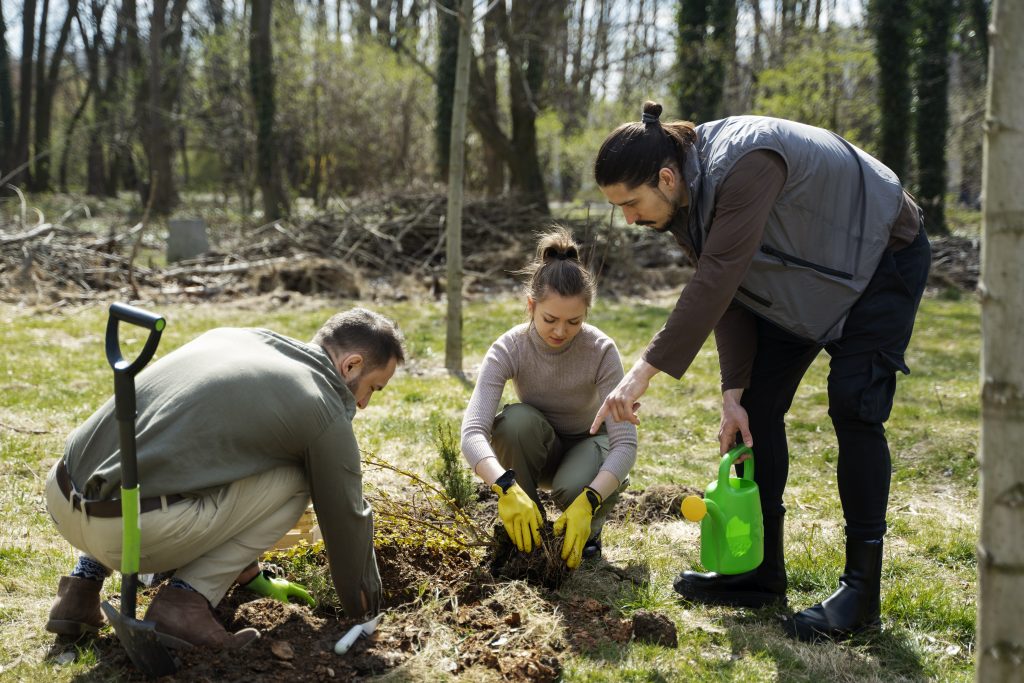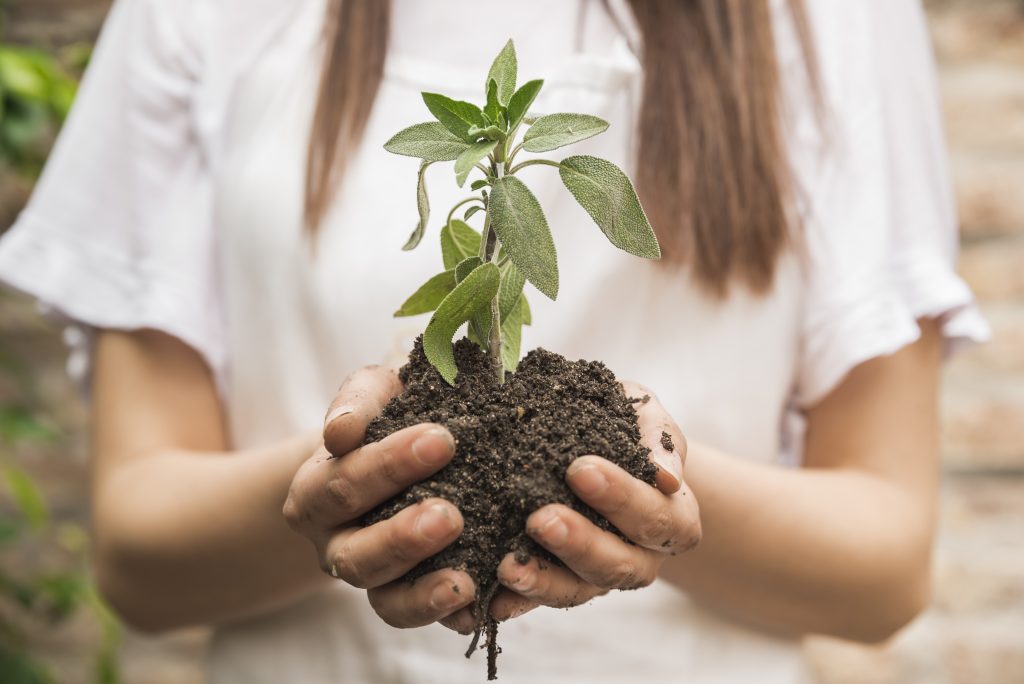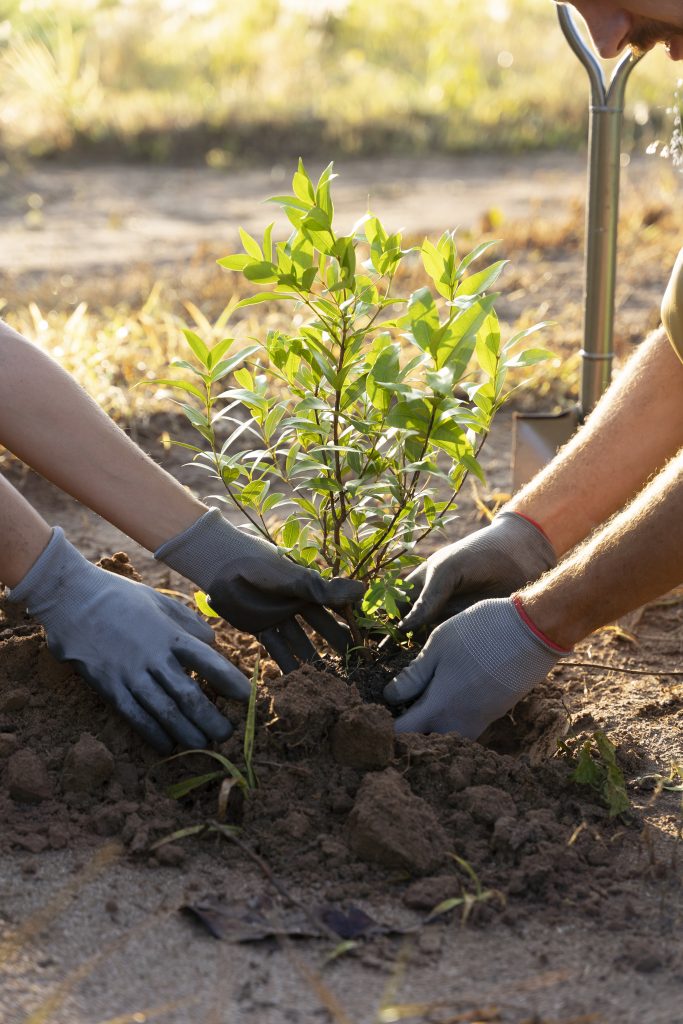PROPERLY PLANTING NEW TREES ON YOUR PROPERTY
Proper tree planting techniques are crucial for the successful establishment and growth of new trees. The way a tree is planted sets the stage for its entire lifespan, influencing its health, vigor, and overall contribution to the environment. Here's an extensive explanation of the importance of proper tree planting techniques:

- Root Development:
- Proper planting ensures that a tree's roots have sufficient space to grow and expand. A well-structured planting hole allows roots to establish a strong foundation, which is essential for nutrient and water uptake.
- Reduced Stress:
- Trees subjected to improper planting techniques, such as planting too deep or too shallow, can experience stress that inhibits their growth. Proper planting minimizes stress, promoting healthier growth.
- Nutrient and Water Uptake:
- Correct planting depth ensures that the tree's root system can access essential nutrients, water, and oxygen in the soil. This is vital for the tree's overall health and vigor.
- Establishment Period:
- Proper planting increases the likelihood of a tree surviving its establishment period, which is when the tree is adapting to its new environment. Trees planted incorrectly are more vulnerable to mortality during this phase.
- Long-Term Growth:
- Trees that are planted properly are more likely to establish strong root systems and develop a healthy canopy. This sets the stage for consistent growth and long-term health.
- Resistance to Environmental Stressors:
- Trees planted using proper techniques are better equipped to withstand environmental stressors such as drought, extreme temperatures, and disease.
- Disease Prevention:
- Proper planting minimizes the risk of disease entry points, such as crown rot, which can occur if the root collar is buried too deeply.
- Structural Integrity:
- Trees that are planted correctly are less likely to develop structural issues like girdling roots or leaning trunks, which can lead to stability problems in the future.
- Faster Establishment: - Properly planted trees tend to establish more quickly, developing a strong root system and canopy that contribute to their overall growth rate.
- Aesthetic Appeal: - Properly planted trees are more likely to exhibit healthy, balanced growth, enhancing the overall appearance of the landscape.
- Environmental Benefits: - Healthy trees provide numerous environmental benefits, including carbon sequestration, oxygen production, and habitat for wildlife. Proper planting contributes to these benefits by ensuring the tree's longevity.
- Economic Investment: - Properly planted trees offer a better return on investment, as they are more likely to thrive and provide value to the property over time.
- Reduced Maintenance: - Trees that are established using proper techniques require less maintenance and interventions, saving property owners time and resources in the long run.
- Ecosystem Health: - Proper tree planting contributes to the overall health of ecosystems by maintaining a diverse tree population that supports wildlife and improves ecosystem services.
- Educational Opportunities: - Proper tree planting provides an educational opportunity for homeowners, communities, and organizations to learn about the importance of proper care for trees and the environment.
In summary, the importance of proper tree planting techniques cannot be overstated. By following the correct practices, property owners contribute to the long-term health, vitality, and contributions of trees to the environment. Investing time and effort in proper planting ensures that new trees have the best possible start, leading to their successful establishment and growth for generations to come.
Tree Selection:
Choosing the right tree species for your climate, soil type, and available space is a critical decision that significantly impacts the long-term health, growth, and success of the tree. Selecting a tree that is well-suited to its environment ensures that it can thrive, contribute to the ecosystem, and avoid potential challenges that might arise from mismatched conditions. Here's a discussion of the importance of making the right tree species choice:

**1. Climate Adaptation:
- Different tree species have varying levels of tolerance to temperature extremes, precipitation patterns, and humidity levels. Choosing a tree that is adapted to your local climate ensures it can withstand the environmental conditions it will face throughout the year.
**2. Reduced Stress and Transplant Shock:
- Trees that are naturally suited to your climate experience less stress when planted. They are less likely to suffer from transplant shock, a common issue that can negatively impact tree health when a tree is moved from one environment to another.
**3. Water Efficiency:
- Selecting a tree species that is well-matched to your local rainfall patterns reduces the need for excessive irrigation. Native or adapted species often require less supplemental watering once established.
**4. Soil Compatibility:
- Different tree species have specific soil preferences. Choosing a tree that matches your soil type promotes better root growth, nutrient uptake, and overall health.
**5. Disease Resistance:
- Some tree species are naturally more resistant to common diseases in your area. By selecting disease-resistant species, you decrease the risk of future disease outbreaks.
**6. Insect Tolerance:
- Trees adapted to your region are more likely to have natural defenses against local insects and pests, reducing the need for frequent pesticide use.
**7. Longevity and Growth Rate: - The right tree species can grow at an appropriate rate for your available space. Avoid planting trees that will outgrow their allotted space, leading to future conflicts with buildings, utilities, or other trees.
**8. Wildlife Support: - Native trees often provide food and habitat for local wildlife, contributing to ecosystem health. Choosing species that support local wildlife can enhance biodiversity.
**9. Aesthetics and Landscape Design: - Selecting the right tree species ensures that your landscape achieves the desired aesthetic goals. Trees that complement the surrounding environment enhance the overall visual appeal.
**10. Property Value: - Well-chosen trees that are healthy and thriving can positively impact property value and curb appeal. Unhealthy or unsuitable trees might have the opposite effect.
**11. Environmental Impact: - Choosing trees that are adapted to your area minimizes the risk of invasive species introduction and potential disruptions to local ecosystems.
**12. Educational Opportunities: - Researching and selecting appropriate tree species provides an educational opportunity for learning about local ecology, plant biology, and the importance of native species.
In conclusion, choosing the right tree species for your climate, soil type, and available space is a decision that has far-reaching consequences. It impacts the tree's ability to survive, grow, and contribute positively to the environment. By taking the time to research and select suitable species, property owners can ensure that their trees have the best chance of flourishing for years to come.
Site Preparation
Site preparation is a crucial step in ensuring the successful establishment of a newly planted tree. Properly preparing the planting site creates optimal conditions for the tree's root growth, nutrient uptake, and overall health. Here's how to prepare the planting site:

- Clear Debris:
- Start by removing any debris, such as rocks, sticks, or old plant material, from the area where you plan to plant the tree. This creates a clean and open space for the tree's roots to grow without obstacles.
- Mark the Planting Area:
- Use stakes and twine or spray paint to mark the boundaries of the planting area. This helps you visualize the space and prevents accidental disturbance during the preparation process.
- Weed Removal:
- Remove existing grass, weeds, and vegetation within the marked area. Competition from weeds can hinder the tree's growth and access to nutrients and water. Use a shovel, hoe, or other appropriate tools to effectively remove weeds.
- Organic Mulch Application:
- Apply a layer of organic mulch, such as wood chips or shredded leaves, to the planting area. Mulch helps suppress weed growth, retains soil moisture, and improves soil structure. Avoid piling mulch against the tree's trunk.
- Soil Testing:
- Perform a soil test to determine the soil's pH and nutrient levels. This information can guide you in deciding if soil amendments are necessary for optimal tree growth.
- Soil Amending (If Necessary):
- Based on the soil test results, you may need to amend the soil to improve its structure and nutrient content. Common soil amendments include compost, well-rotted manure, and other organic matter.
- Proper Drainage:
- Ensure that the planting area has good drainage to prevent waterlogging, which can lead to root rot. If the soil doesn't drain well, consider creating a raised planting mound.
- Adequate Sunlight:
- Choose a planting location that receives the appropriate amount of sunlight for the specific tree species. Different trees have varying light requirements, so select a spot that meets the needs of the chosen tree.
- Avoid Compaction:
- Avoid heavy foot traffic and machinery around the planting site to prevent soil compaction, which can hinder root growth and water infiltration.
- Site Accessibility: - Consider how accessible the planting site is for watering, maintenance, and future care. Ensure that you can easily reach the tree for ongoing attention.
- Protective Measures: - If the site is prone to wildlife browsing or other potential threats, consider using tree guards or fencing to protect the newly planted tree.
- Soil Temperature Consideration: - Plant trees at the appropriate time of year when the soil temperature is suitable for root growth. Planting during cooler periods allows the tree to establish roots before facing extreme weather.
By following these steps, you can create an ideal environment for the newly planted tree. Adequate site preparation sets the stage for successful establishment, promotes healthy root development, and contributes to the long-term health and vitality of the tree.
If you need a tree service in Utah, you can call:
Truco Services, Inc.
4640 Commerce Drive
Murray, Utah 84107
(801) 466–8044
https://truetreeservices.com/
Comments
Post a Comment